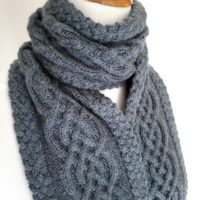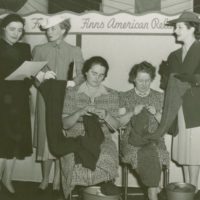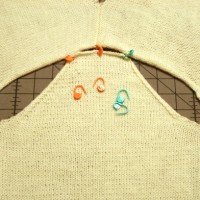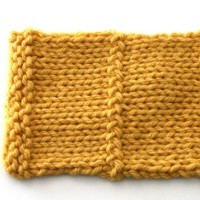Sometimes patterns, especially older patterns, will tell you to decrease without specifying which decrease to use. Or you may be working a pattern where you think a different decrease will work better than the one the pattern calls for. In this video, I compare three popular decreases side-by-side so you can see the differences.
Slow demonstrations of the three decreases:
Knit Two Together (k2tog)
Slip, Slip, Knit (SSK)
Pass Slipped Stitch Over (PSSO)
The bulky yarn I used for demonstration is Knit Picks Wool of the Andes Bulky in Yonder.
The needles I’m using are Knitter’s Pride Nova Platinas, from an interchangeable set.
The nail polish I’m wearing is by Julep, color “Amanda”.
My silver ring is actually a knitting needle gauge, and can be found here.







Well that’s certainly a helpful bit of info! I usually wing it, haha.
Also–can I just say what a great name ‘Yonder’ is for a yarn color? So whimsical!
This video came at a perfect time. I am working on a scarf pattern that requires decreases and increases. It is the Manchester Scarf on Raverly. I was having problems with the increases and decreases.
Another great video. Thank you Staci!
I’ve recently rediscovered my love of knitting and I’ve been going back and watching all your instructional videos and have learned so much in such a short time. I find I look forward to the release of each new video!
It is very helpful for me to see the different decreases and you have them
shown in knitting all in the same piece .. I am very visual for me this is
greatly appreciated.
thank you Staci 🙂
Is there a left leaning increase that you know of that “matches” psso?
Sue – there isn’t really a stitch that mirrors the strong look of the PSSO, k2tog is the best match. To get the same look on a right-leaning decrease would be really complicated – working stitches, then slipping them back to the left needle, then binding-off (the wrong way) one stitch over the other, and slipping the stitches back. It can be done, but I don’t know of it ever being used in a pattern because it would slow your knitting down so much.
S t a c i
Excellent video as always. I can never make up my mind which decrease I like better. Just wanted to pass along something someone shared with me. For psso, if you slip it knitwise with the yarn in back, then pass it over, you won’t have that line in front. Can’t wait for the next video!
Hi Staci…another great video! Thank you so much for all you do. It’s really appreciated. Here’s my question…When decreasing the crown of a hat that has an alternating pattern, how do you keep that pattern even? I’ve tried and tried but always end up with the pattern repeats next to each other at the beginning of the round. By the way, I just completed your fairi isle hat pattern. It turned out great and was sooo much fun! Thanks again,
Donna Carrier
Donna – thank you for the note. I’m not sure I understand your question, but I’ll try to answer – really, if you’re not experienced with writing/altering patterns, it’s best to follow a trusted pattern. If you’re working out the decreases for the crown of the hat, you want to make sure that the pattern repeat is able to repeat all the way around. If the repeat is “k2tog, k8”, you want to be sure the round ends with k8, so that you don’t end up with two k2togs next to each other, and the beginning and end of the round.
S t a c i
Hi Staci, decreasing always confuses me!!!
The pattern I am working on at the moment is asking me to cast off 3 stitches at the beginning of the next 2 rows, which method of decreasing would you recommend for decreasing this amount of stitches at one time. I am knitting a baby matinee coat and the decrease is for shaping the armholes.
Your help and guidance is always very much appreciated.
Thanks
Chrisann – your pattern is being specific here about how to decrease…you need to bind-off those stitches, the same way you would bind off when you’re finished with a project:
https://verypink.com/2010/03/13/video-binding-off/
S t a c i
Staci, I’m knitting in the round: knit 1 purl 1 hat and now I have to a begin decreasing. What do I do to not mess up the K1P1 pattern? I’d love your suggestions.
Hi Staci, My new knitting pattern calls for a Central Double Decrease (CDD). I have never heard of that stitch before and I noticed that you didn’t have a video showing it. I did figure it out and thought maybe it would be helpful to others. Thanks for all your help.